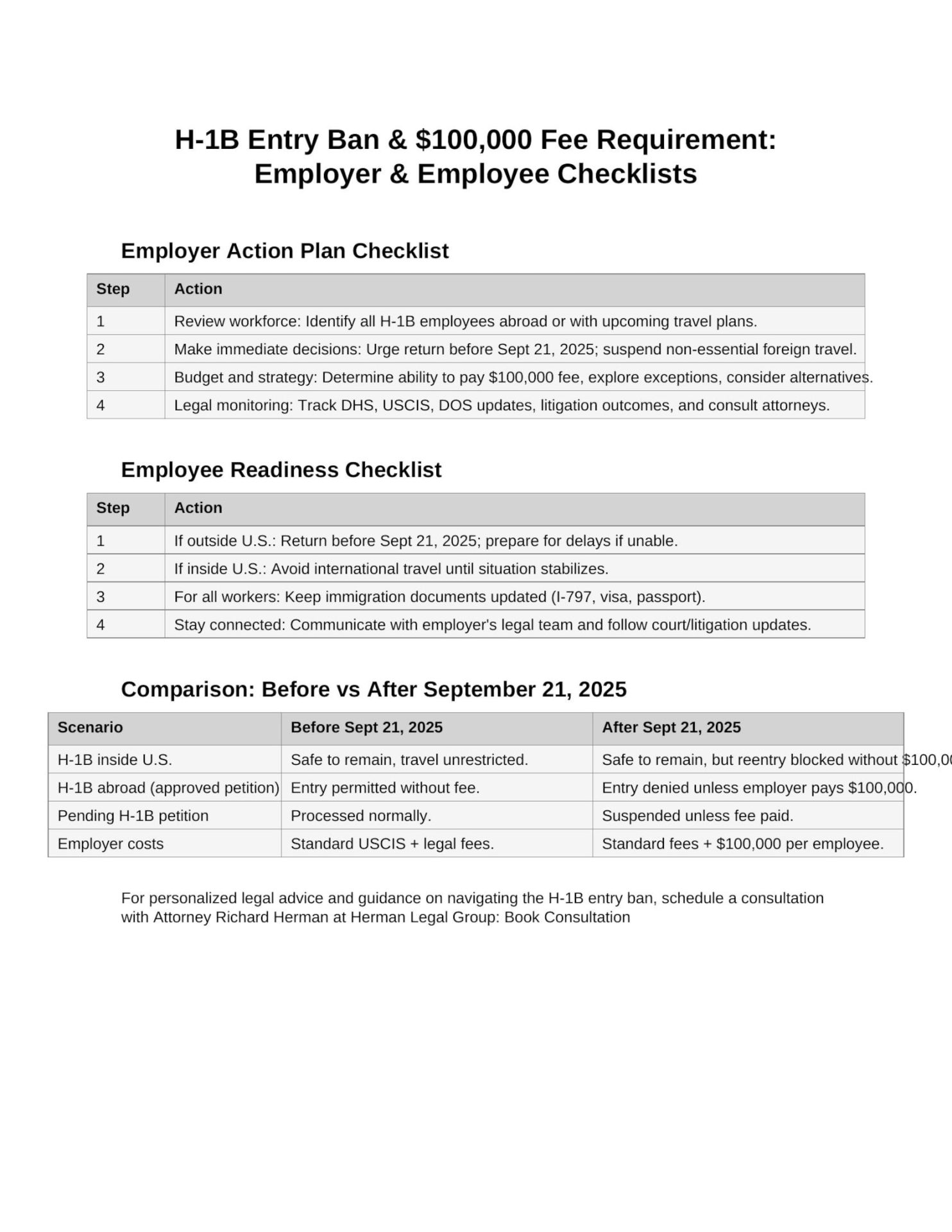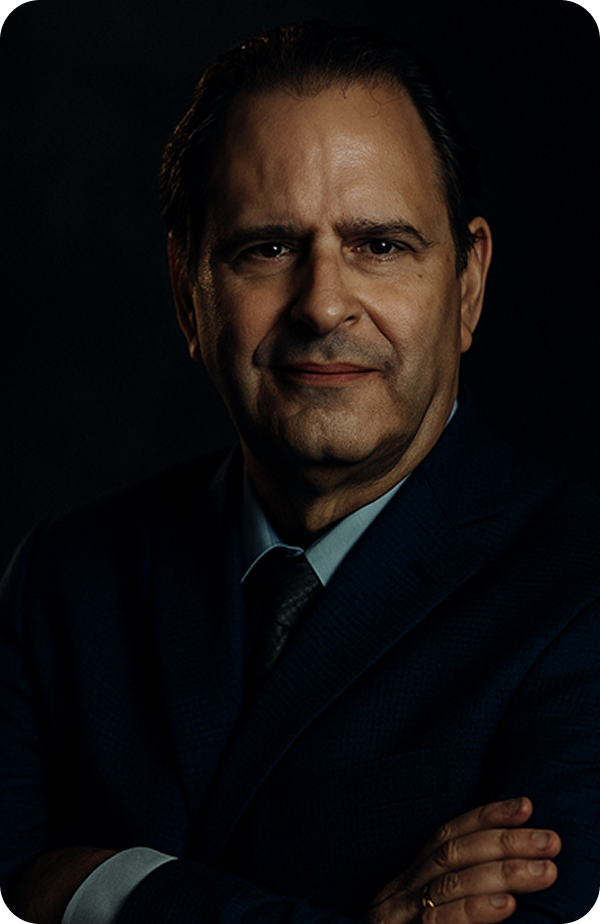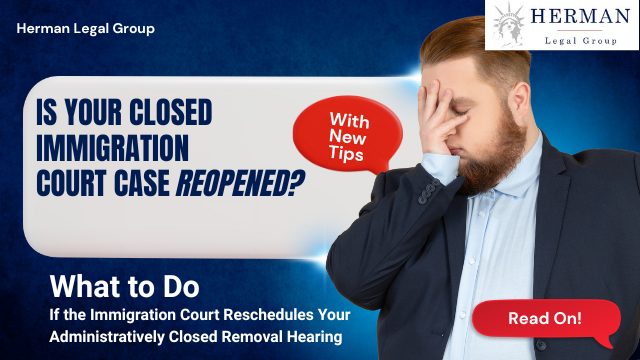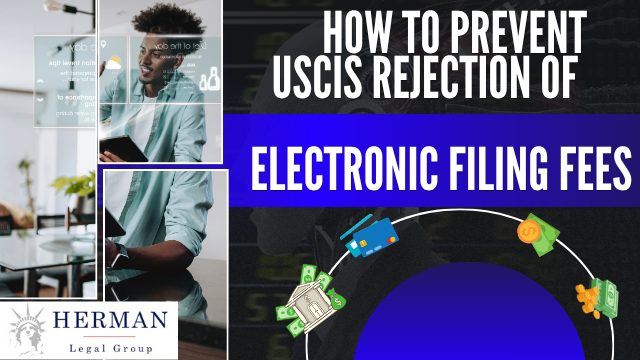9/22/2025 UPDATE: H1B $100,000 Filing Fee
Trump’s $100K H‑1B Fee: USCIS Clarifies Who Pays and Who’s Exempt
The U.S. Citizenship and Immigration Services (USCIS) has issued new guidance following President Trump’s September 19, 2025 proclamation imposing a $100,000 fee on new H‑1B visa petitions.
This has sparked widespread concern among employers, international professionals, and policy analysts. However, USCIS has now clarified key details, confirming who must pay—and who is exempt—from this unprecedented visa cost.

What Is the $100,000 H‑1B Fee?
The new order, titled “Restriction on Entry of Certain Nonimmigrant Workers”, imposes a $100,000 filing fee on certain new H‑1B petitions starting September 21, 2025 at 12:01 a.m. ET.
“This is not an annual fee,” emphasized White House Press Secretary Karoline Leavitt. “It’s a one-time petition fee, and it does not affect those already holding H‑1B status.”
Who Does the New H‑1B Fee Apply To?
The proclamation applies only to a specific set of cases. Here’s what you need to know:
The fee applies to:
-
New H‑1B petitions filed on or after September 21, 2025
-
Individuals not currently holding valid H‑1B status
-
Petitions for initial H‑1B status or re-entry from abroad
-
Filings submitted without a national interest waiver
The fee does not apply to:
-
Petitions filed before September 21, 2025
(USCIS clarification on X) -
Current H‑1B visa holders, regardless of location
-
Renewals, amendments, or extensions of H‑1B status
-
Travel or re-entry for individuals with valid H‑1B visas
Proclamation Summary
The September 19 proclamation was issued under sections 212(f) and 215(a) of the Immigration and Nationality Act, granting the president broad authority to restrict noncitizen entry.
The core language of the proclamation states:
“…the entry into the United States of aliens as nonimmigrants to perform services in a specialty occupation under section 101(a)(15)(H)(i)(b)… is restricted, except for those aliens whose petitions are accompanied or supplemented by a payment of $100,000.”
You can read the full official document on the White House website.
Key Clarifications from USCIS
USCIS quickly followed the proclamation with clarifying statements, including:
-
The new fee only applies to petitions not yet filed by the effective date.
-
Existing approved petitions and current H‑1B holders are unaffected.
-
Re-entry for visa holders outside the U.S. is not impacted.
-
The fee is not annual, but one-time and tied to the petition, not to the individual.
Official USCIS guidance was posted directly on their X (Twitter) account and USCIS Newsroom.
Visual Guide: Who Pays and Who Doesn’t
To help clarify the impact, refer to this downloadable Before vs. After chart (JPEG), highlighting categories affected by the new rule.
Timeline of Events
| Date | Event |
|---|---|
| Sept 19, 2025 | Proclamation signed by President Trump |
| Sept 21, 2025 | Fee rule goes into effect at 12:01 a.m. ET |
| Sept 21–22, 2025 | USCIS and White House clarify exemptions and scope |
Outstanding Questions and Concerns
While the proclamation and USCIS statements have clarified much, several grey areas remain:
-
Who qualifies for a national interest waiver?
The proclamation allows for waivers but doesn’t define specific standards. DHS may release criteria later. -
How will the fee be processed?
No details yet on logistics—will it be part of Form I-129 or a separate transaction? -
What about portability (change of employer)?
The rule’s impact on H‑1B job changes remains unclear, though likely exempt if visa status is continuous. -
Could litigation challenge the proclamation?
Legal challenges from industry or civil rights groups are possible but not confirmed.
FAQs: H‑1B $100,000 Petition Fee
Is this a recurring or annual fee?
No. This is a one-time petition fee, not an annual cost.
Does it apply to current H‑1B visa holders?
No. Anyone already in H‑1B status is exempt, including those temporarily outside the U.S.
Can employers or employees appeal the fee?
Only if they qualify for a national interest waiver, which has yet to be fully defined.
What if my petition was already filed before Sept 21?
You’re safe. The new fee does not apply retroactively.
Does this affect other visa categories like L-1 or O-1?
No, the fee is specific to H‑1B petitions.
Strategic Takeaways for Employers and Petitioners
Employers:
-
Reassess hiring timelines to submit petitions before the effective date.
-
Budget for increased costs if hiring foreign workers post-September 21.
-
Consult with immigration counsel to explore waiver possibilities.
Employees:
-
Ensure H‑1B petitions are filed early to avoid the fee.
-
Avoid international travel near the cutoff date if petition is pending.
-
Stay informed on future USCIS guidance and possible fee processing updates.
Why This Matters
The H‑1B program is a cornerstone of U.S. tech and STEM employment. A six-figure filing fee may act as a barrier to entry for smaller companies, startups, and academic institutions who rely on international talent.
According to the Congressional Research Service, more than 300,000 H‑1B workers currently reside in the U.S., many in high-demand fields like AI, biotech, and software engineering.
This proclamation represents the most financially aggressive immigration fee ever imposed on a single visa category.
Conclusion
The $100,000 H‑1B petition fee introduces a seismic shift in U.S. immigration policy—but clarifications from USCIS have ensured that existing visa holders and in-process applicants are protected.
As the dust settles, businesses and workers alike must stay agile, well-informed, and ready for further updates as implementation unfolds.
On September 19, 2025, President Donald Trump signed a proclamation that places a significant restriction on the entry of H-1B visa holders into the United States. President Trump and the Trump administration are the driving force behind this policy. The policy was enacted through an executive order and announced by the Commerce Secretary, with administration officials providing statements to explain the rationale behind the new measures. Starting on September 21, 2025, foreign nationals who are entering the U.S. under the H-1B visa program must ensure that their employer has paid a $100,000 fee in order to gain entry. The technology sector and American companies rely heavily on H-1B visas to attract highly skilled workers, and this policy could impact the U.S. innovation edge. All the big companies and big companies in the tech industry are closely watching the policy’s effects and have expressed concerns about the new requirements. This move comes with significant implications for employers, workers, and the overall H-1B program.
THE FOLLOWING WAS PUBLISHED ON 9/202/2025
It is expected that there will be federal court litigation challenging this proclamation. We will keep you updated.
For now, here’s a breakdown of what this means for you.
Key Highlights of the Proclamation
- Effective Date: The entry ban and fee requirement go into effect on September 21, 2025, at 12:01 am EDT (Eastern Daylight Time).
- $100,000 Fee Requirement: Employers must pay a $100,000 fee for any H-1B employees seeking entry into the U.S.
- Exceptions: The Department of Homeland Security (DHS) can grant exceptions for foreign nationals who are found to be working in the national interest or whose entry does not pose a threat to U.S. national security or welfare.
- 12-Month Duration: The entry ban is initially set for 12 months but could be extended based on recommendations from federal immigration agencies.
Which Foreign Nationals Are Affected?
The new proclamation applies to all foreign nationals seeking to enter the United States to work under the H-1B program after the effective date. This restriction will also apply to new H-1B visa applicants, including those whose petitions are in progress or pending approval. Notably, the new $100,000 fee represents a significant increase over the current system of visa fees, which previously required only smaller payments from companies seeking to hire foreign talent.
Specifically:
- New H-1B Petitions: Any new or pending H-1B petition for foreign nationals applying for a U.S. visa must be accompanied by the $100,000 fee to be considered valid. These new fees apply to all companies seeking to sponsor H-1B workers, marking a substantial change from the previous visa fee structure.
- Approved Petitions Before September 21, 2025: The proclamation raises questions about whether those with H-1B petitions or visas approved before the effective date are impacted. While the proclamation is clear in its wording, there are discrepancies when compared to the accompanying White House fact sheet. Until further clarification, employers should act according to the proclamation.
What Happens if the $100,000 Fee Isn’t Paid?
If the $100,000 fee is not paid, foreign nationals with an approved H-1B petition will not be allowed to enter the United States. Employers may also face subsequent fees during the application process, further increasing the financial burden. Furthermore, the Department of Homeland Security (DHS) is instructed to suspend decisions on H-1B petitions for those outside the U.S. who have not paid the fee. The Secretary of State will also withhold approval for H-1B visa applications unless the fee is paid, and immigration services will be responsible for verifying payment before processing H-1B applications.
National Interest Exceptions: Who Qualifies?
The proclamation allows DHS to grant exceptions to the entry ban under specific circumstances. These exceptions can be made for:
- Individual Foreign Nationals: If it is determined that their employment is in the national interest and does not threaten U.S. security or welfare.
- Specific Employers or Industries: DHS can also grant exemptions for foreign nationals working for certain employers or in industries that are critical to the U.S. economy, security, or other national priorities. Exceptions may be granted to support keeping firms competitive, filling talent gaps, and recognizing that highly skilled workers are essential for economic growth and innovation. Attracting the world’s smartest talent is critical for maintaining US leadership in technology and science.
However, DHS has yet to establish a formal process for applying for these exceptions, so further guidance is expected.
Potential Changes to Employment-Based Nonimmigrant Rules
The proclamation also signals potential changes to the way employment-based visas, including the H-1B, will be regulated. According to a senior official involved in immigration policy, these new rules and the updated fee structure are part of a broader effort to reform the visa system. Previously, H-1B applications required only a small fee, but under the new rules, a new fee of $100,000 may be implemented, representing a significant shift in policy. This move follows Trump’s threat to impose a $100,000 annual fee on H-1B visas, highlighting the administration’s intent to overhaul the program and its impact on the tech industry.
- H-1B Visa Quotas: DHS is set to implement a weighted system for prioritizing H-1B petitions. This system will likely favor higher-paying roles and more qualified foreign nationals. Additionally, higher paying employers may be prioritized under the new rules.
- Changes to the Prevailing Wage System: The Department of Labor (DOL) is expected to propose changes to the H-1B prevailing wage system. These changes may include raising wage thresholds, which would significantly impact employers and visa applicants.
These changes are part of an ongoing push to restrict the flow of lower-paid foreign workers and ensure that higher-paying, more skilled positions are prioritized.
What Should H-1B Employers and Employees Do Now?
Given the uncertainty surrounding the new entry ban, employers and H-1B foreign nationals should take the following steps to minimize disruptions:
- Return to the U.S. Before September 21: If you are currently outside the U.S. with an approved H-1B petition and visa, make arrangements to return before the effective date to avoid the entry ban.
- Postpone Foreign Travel: If you are an H-1B visa holder planning to travel outside the U.S. after September 21, 2025, hold off on your travel plans until the full scope of the entry ban is clarified. If travel is unavoidable, be prepared for significant delays upon reentry.
- Stay Informed: Both employers and foreign nationals should monitor legal updates closely. It’s expected that litigation will challenge the entry ban, and court rulings could change the situation quickly.
- Consider Domestic Hiring and Training: Employers may want to focus on efforts to train Americans and recent graduates from U.S. universities, and prioritize strategies to hire Americans in response to the new restrictions.
B-1/B-2 Visa and H-1B Workers
The proclamation also touches upon the misuse of B-1/B-2 visas by prospective H-1B workers. The B-1/B-2 visa allows foreign nationals to enter the U.S. for business or tourism. However, some H-1B workers may attempt to enter as tourists while waiting for their H-1B status to be processed. In addition, some employers require temporary foreign workers to sign nondisclosure agreements, which can limit their ability to report abuses or discuss employment conditions.
The proclamation directs the Secretary of State to issue guidance that prevents individuals with an approved H-1B petition from misusing the B visa. This could mean heightened scrutiny for those entering the U.S. under the Visa Waiver Program (VWP) or applying for a B visa while waiting for H-1B approval, including closer examination of the use of nondisclosure agreements in the context of visa compliance.
What’s Next for H-1B Workers?
H-1B visa workers will need to navigate several changes in how the U.S. will process and prioritize their petitions:
- New Rulemaking: The Department of Homeland Security is working on new rules that will affect H-1B petitions and other employment-based visas. This may include prioritizing workers in higher-paying jobs or those who meet certain education or skill level requirements. The new rules are intended to address talent gaps and fill jobs in critical sectors, but may also make it harder to fill occupational shortages if qualified domestic workers are not available.
- Prevailing Wage Changes: The Department of Labor (DOL) may propose changes to how H-1B prevailing wages are calculated. This could make it harder for some employers to afford to sponsor foreign workers, particularly those in lower-wage fields. These changes could impact technology workers and tech workers by altering the supply of skilled labor, potentially affecting the ability to fill occupational shortages in the tech industry.
What Employers and Employees Should Do Next
Until more guidance is available, here’s a summary of actions to take:
- Plan Travel Carefully: Employers should inform employees planning international travel to delay trips until the situation is clarified.
- Review H-1B Petitions: Employers should ensure that their H-1B petitions are compliant with the new proclamation, especially regarding the $100,000 fee.
- Monitor Legal Challenges: Legal challenges to the proclamation are expected. Employers and employees should stay updated on any changes, especially in response to court decisions.
- Consult an Immigration Attorney: If you have concerns or need to understand how this new rule will affect you or your company, contact an immigration attorney for personalized advice.
This policy is intended to protect American workers, improve American workers’ wages, and address concerns raised by American IT workers about job displacement.
Here is our checklist for employers and employees:

Complete FAQ Guide: President Trump’s H-1B Entry Ban and $100,000 Fee Requirement: (September 2025)
Starting September 21, 2025, President Trump’s proclamation bans H-1B visa workers from entering the U.S. unless their employer pays a $100,000 fee per worker. The policy applies to new, pending, and existing H-1B petitions. Exceptions may be granted if the Department of Homeland Security (DHS) determines the employment is in the national interest.
The U.S. technology sector relies heavily on legal immigration pathways like the H-1B program to attract highly skilled foreign workers, who are essential for innovation and competitiveness.
This guide provides an in-depth look at the ban, the fee, its impact, and what employers and employees need to know right now.
At a Glance
- Effective Date: September 21, 2025 (12:01 a.m. EDT).
- Requirement: $100,000 fee for each H-1B worker entering the U.S.
- Applies To: New, pending, and approved H-1B petitions.
- Duration: 12 months, with possible extension.
- Exceptions: Allowed for individuals, employers, or industries in the national interest.
- Enforcement: DHS and State Department instructed to block approvals without fee verification.
FAQ Section 1: Understanding the Ban
What is the H-1B entry ban and fee requirement?It’s a presidential proclamation signed on September 19, 2025, requiring employers to pay $100,000 for each H-1B worker seeking entry. The ban was announced by the US president from the Oval Office as part of the Trump administration’s broader immigration policy. Without payment, workers cannot be admitted, and petitions or visas may be suspended or denied.
Who is covered under this rule?
- Any foreign national entering under an H-1B visa after September 21, 2025.
- Workers with new petitions, pending cases, or previously approved visas.
Does it affect people already inside the U.S. on H-1B?No. Workers already inside the U.S. are not barred. But travel outside the U.S. after the effective date risks denial of reentry unless the fee is paid.
FAQ Section 2: The $100,000 Fee
Why is there a $100,000 fee for H-1B entries?The administration argues the fee offsets what it calls “economic displacement” caused by foreign workers and discourages reliance on lower-paid H-1B hires. However, this fee is far higher than the several thousand dollars previously required for H-1B applications, and risks taxing companies—especially smaller firms—while it creates disincentive for hiring foreign talent. The new fee could hit smaller tech firms especially hard, making it more difficult for them to compete for international talent. Smaller tech firms may struggle to absorb the increased costs compared to larger corporations.
Who must pay the fee?
- The employer sponsoring the H-1B worker.
- Payment cannot be shifted to the employee under existing labor rules.
What happens if the fee is not paid?
- USCIS will suspend the petition.
- DOS will deny the visa.
- The worker will be denied entry at ports of entry.
How will the fee be paid and verified?Procedures are pending. DHS and DOS are instructed to establish verification before approvals.
FAQ Section 3: Exceptions and Waivers
What are national interest exceptions?DHS can grant exemptions if:
- The worker’s employment is in the U.S. national interest.
- The worker does not pose a threat to U.S. security or welfare.
Who can get exceptions?
- Individuals with critical skills.
- Employers in essential industries.
- Entire industries, such as healthcare, cybersecurity, or defense.
Exceptions may be necessary to obtain highly skilled workers, attract the world’s smartest talent, and ensure the U.S. continues to draw the best talent globally.
How do employers apply for exceptions?DHS has not yet issued guidance. Employers should monitor official DHS announcements for application procedures.
FAQ Section 4: Travel and Timing
What should H-1B workers abroad do?
- Return before September 21, 2025 if possible. The ban could impact overall STEM employment, including recent graduates from great universities who are seeking to begin their careers in the U.S.
- If unable, await further DHS guidance or court rulings.
What if an H-1B worker travels after September 21?They may not be allowed reentry unless their employer pays the fee. This restriction could also affect stem employment opportunities for both foreign and domestic workers.
How long will the ban last?Initially 12 months, but it can be extended and may affect FY 2027 H-1B cap beneficiaries.
FAQ Section 5: Broader Impacts
How does this affect B-1/B-2 visa holders with H-1B petitions?The State Department has been directed to prevent misuse of B visas. Applicants with pending or approved H-1Bs may face heightened scrutiny when seeking B visas or Visa Waiver entry.
What industries are most impacted?
- IT consulting and outsourcing firms, which file high volumes of H-1B petitions.
- Healthcare providers relying on foreign physicians.
- Startups and mid-sized companies unable to afford the $100,000 fee.
- The tech industry has contributed millions to advocacy efforts and is exploring alternatives such as gold card programs in other countries.
Could this lead to more offshoring?Yes. Employers may increasingly keep roles overseas instead of paying the fee, potentially shifting U.S. jobs abroad. The new fee could force companies to move high value work overseas, especially in technology and AI, to manage costs and maintain competitiveness.
FAQ Section 6: Legal Challenges
Is the proclamation legally binding?Yes, unless blocked by a federal court. Presidential proclamations carry the force of law.
Are lawsuits expected?Yes. Immigration advocacy groups and business coalitions are preparing challenges. Possible claims:
- Violation of the Immigration and Nationality Act (INA).
- Improper taxation without congressional approval.
- Harm to U.S. businesses and innovation.
Analysts suggested the policy could have long-term negative effects on U.S. innovation, with eMarketer analyst Jeremy Goldman highlighting potential risks to the tech sector.
Could courts pause implementation?Yes. Federal courts may issue injunctions that temporarily suspend enforcement.
FAQ Section 7: Future of the H-1B Program
Will there be changes to the H-1B lottery?Yes. DHS is instructed to propose a weighted lottery favoring high-paid, highly qualified workers. Future changes are likely to focus on attracting highly skilled workers, as these skilled workers are essential for maintaining U.S. competitiveness and innovation.
What about H-1B wages?DOL may introduce rules raising prevailing wage levels. A prior attempt in 2020 was blocked in court, but new proposals may be crafted to survive legal challenges.
Could this affect other visa categories?Not directly yet. But DHS has authority to explore changes across employment-based nonimmigrant visas (such as L-1 or O-1).
FAQ Section 8: Employer and Worker Action Plan
What should employers do right now?
- Urge H-1B workers abroad to return before September 21.
- Pause non-essential foreign travel for current H-1B employees.
- Budget for the possibility of the $100,000 fee.
- Track DHS and court updates daily.
- Consult legal counsel for strategies and exceptions.
What should employees do right now?
- Enter the U.S. before the ban starts, if possible.
- Postpone foreign travel until the situation stabilizes.
- Stay informed on litigation outcomes and policy updates.
- Consult with an immigration lawyer to assess risks.
FAQ Section 9: Long-Term Questions
Could the fee become permanent?Yes. Although the current ban is for 12 months, extensions or congressional codification could make it permanent.
Will this affect the FY 2026 and FY 2027 H-1B cap?Yes. Workers selected in FY 2026 or FY 2027 may face additional hurdles if the fee requirement is extended.
What alternatives exist if employers cannot pay?
- Remote overseas employment.
- Other visa categories (O-1 for extraordinary ability, TN for Canadian/Mexican professionals, etc.). Companies seeking to hire foreign talent through these alternatives should be aware that subsequent fees and additional hurdles may apply, potentially increasing the financial burden.
- Exploring permanent residency (green card) sponsorship if eligible.
Conclusion
President Trump’s H-1B entry ban and $100,000 fee requirement represents one of the most sweeping restrictions ever placed on the H-1B program. The rule dramatically increases employer costs, creates uncertainty for foreign professionals, and could shift jobs overseas.
Employers and workers should:
- Act quickly before September 21, 2025.
- Stay informed about court challenges and DHS guidance.
- Seek legal advice to explore compliance, exceptions, and long-term strategies.
Need Help Navigating Trump’s H-1B Travel Ban? Contact Attorney Richard T. Herman Today
If you or your company is affected by President Trump’s September 19, 2025 H-1B entry ban and $100,000 fee requirement, you cannot afford to wait. The rules are complex, exceptions are unclear, and the risks of making the wrong move are enormous. Employers could face blocked petitions, delayed projects, or the loss of top talent. Foreign professionals risk being stranded abroad, denied entry, or forced into career-altering disruptions.
That’s why you need an experienced immigration lawyer who understands both the law and the strategy behind it.
Attorney Richard T. Herman, founder of the Herman Legal Group, has more than 30 years of experience helping employers and immigrants navigate sudden immigration shifts. He and his multilingual team are prepared to:
- Analyze whether your case may qualify for a national interest exception.
- Advise employers on whether and how to comply with the $100,000 H-1B fee.
- Protect employees at risk of being denied entry at U.S. borders.
- Provide real-time updates on litigation and policy changes that could affect your case.
- Offer tailored solutions, from compliance strategies to exploring alternative visas.
Immigration law is changing fast, and every decision matters. Don’t risk your future or your business on guesswork. Get trusted, professional guidance from one of America’s leading immigration attorneys.
👉 Schedule your confidential consultation now:
- 📞 Call the Herman Legal Group at 1-800-808-4013
- 🌐 Book online: https://www.lawfirm4immigrants.com/book-consultation/
Consultations are available by phone, Zoom, Skype, or in-office. Services are offered in multiple languages to meet the needs of global professionals.
Don’t wait. Get the answers you need today, and protect your H-1B future.
H-1B Entry Ban (Sept. 19, 2025) — Government & Association Resources
A. Government Sources (Primary / Official)
White House (Proclamation & Fact Sheet)
- Presidential Proclamation: Restriction on Entry of Certain Nonimmigrant Workers (9/19/25)
- White House Fact Sheet: Suspension of Entry of Certain Nonimmigrant Workers
Department of Homeland Security (DHS) / USCIS
- USCIS – H-1B Specialty Occupations Program Overview
- USCIS Newsroom – Latest Alerts and Updates
- Federal Register – Modernizing H-1B Requirements (Final Rule; effective Jan. 17, 2025)
- USCIS Alert – H-1B Final Rule & Revised Form I-129 (effective Jan. 17, 2025)
Department of State (DOS)
U.S. Customs and Border Protection (CBP)
Federal Rulemaking & Planning (Context)
B. Professional Associations & Coalitions (Practice Alerts & Employer Guidance)
American Immigration Lawyers Association (AILA)
U.S. Chamber of Commerce
Tech Industry Coalitions
Society for Human Resource Management (SHRM)
Higher Education / International Mobility (NAFSA)
How to Use This List
- Start with the White House links for proclamation text and official intent.
- Check USCIS/DHS updates for implementation mechanics (fee verification, exception process).
- Verify visa adjudications and travel entry rules via DOS and CBP.
- Monitor associations like AILA, SHRM, and TechNet for practice alerts and litigation updates.
- Track rulemaking Federal Register for interim guidance.








